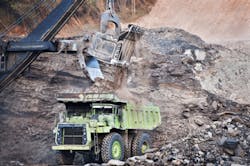MSHA Issues 294 Citations During October and November Impact Inspections
MSHA issued 294 citations in October and November as part of its impact inspection program, which focuses on mines with “poor compliance history or particular compliance concerns.”
The agency launched the monthly inspections in April 2010, after an explosion at the Upper Big Branch-South Mine in West Virginia killed 29 miners.
In November, MSHA issued 174 citations, 11 orders and two safeguards at 12 coalmines on the impact inspection list.
In October, MSHA inspectors issued 120 citations and 10 orders at six coalmines and three metal and nonmetal mines. The agency notes that it had to curtail the inspection program in October due to the government shutdown.
During a Nov. 21 inspection at Maple Coal Co.’s Maple Eagle No. 1 Mine in Fayette County, W.Va., the agency issued 36 citations and six orders. MSHA inspectors traveled belt lines, inspected mobile and stationary equipment, and evaluated section ventilation and roof control.
During the inspection at the Maple Eagle No. 1 Mine, enforcement personnel observed a 20-foot crack in the mine roof at a belt feeder where miners regularly travel. Inspectors also found an area of loose roof strata 60 feet long and up to 8 feet wide where miners were at risk of being struck by falling rock, according to the agency.
MSHA issued a 104(d)(1) withdrawal order for violating the approved roof-control plan and failing to install needed roof supports. The agency also cited Maple Coal Co. for a loose coal rib approximately 24 feet long that was cracked and separating from the solid wall. The hazards had the potential to cause catastrophic injuries or fatalities to miners, according to MSHA.
The Maple Eagle No.1 Mine received three 104(d)(1) withdrawal orders for violating the approved ventilation plan.
“The operator did not properly construct or complete several overcasts (enclosed airways used to maintain ventilation) in several entries,” MSHA said in a news release. “The operator also failed to maintain intake airways clear of combustible materials, and had let water accumulate in one of the entries. The mine operator was cited for failing to identify and correct in its pre-shift inspection hazards that were obvious, extensive and had existed for several shifts.”
Since April 2010, MSHA has conducted 687 impact inspections and issued 11,427 citations, 1,052 orders and 48 safeguards.
